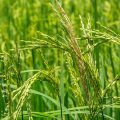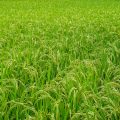The Philippines is hitting 400 metric tons (MT) of fancy rice export by the end of 2013 as it just sent off 100 MT of the Dona Maria hybrid rice to Dubai, aiding Philippines to exceed export target by 300 percent.
The export to Dubai, to be distributed via a big international retail chain, is expected to become a regular export volume to the Filipino market there.
The sendoff was led by DA Undersecretary Dante S. Delima at the Talavera warehouse in Nueva Ecija of SL Agritech Corp.
“This rice is really being awaited for by Filipinos in Dubai. Some of our fellow Filipinos said they don’t want other kinds of rice from other countries that are tough or are not tender or aromatic. They really like Dona Maria Jasponica and Miponica rice,” said SLAC Assistant to the Chairman Michelle Lim-Gankee.
Delima said at the sendoff ceremony that the Philippines will likely hit a 400 MT mark in fancy rice export by yearend.
“We didn’t really anticipate that the response of the international market to our rice will be this warm.” said Delima. “The president (Benigno S. Aquino III) always says our flagship program is food sufficiency. That means we’ll have significant decrease in imports and significant increase in export.”
Already 300 MT of rice has so far been shipped out by the Philippines, he said.
DA will continue to tap opportunities to export fancy rice. And yet it will sustain effort to meet 100 percent rice sufficiency potentially by 2014. The country just imported 187,000 MT of rice this year, ending decades-long importation regime that peaked to some two million MT over the last five years.
While hybrid rice area in the Philippines is just at 150,000 hectares, Gankee said an additional 500,000 hectares of hybrid rice area will easily make Philippines produce an incremental two million MT. That will be more than enough to offset the 187,000 MT of imports in 2013.
That is given the fact that hybrid rice has proven to be capable of raising farmers’ yield by four MT per hectare from the national average yield placed at about 3.5-3.8 MT per hectare.
Just by converting inbred rice into hybrids and following best cultural practices, farmers can harvest eight MT (per hectare) or even more.
“That will be an additional two million tons that can feed 13 million people. We’re proud that this is a premium rice that the export market finds easy to accept. We’re happy to be supporting each other for the whole Philippines to have a world-class quality product,” Gankee said.
DA aided companies in the export through issuance of a special export permit. The Philippines has had decades-long ban against export due to the need to produce food for local consumption.
Nueva Ecija Provincial Agriculturist Serafin Santos planting of hybrid rice in Nueva Ecija is helping farmers recover faster from their losses from the typhoon Santi.
“Hybrid rice has a long history in Nueva Ecija with its ups and downs, but planting goes on. When the typhoon came, already 60 percent was at harvestable stage. (Inevitably), there would be a reduction in yield. But still the increase in yield with hybrid rice is positive,” Santos said.
Delima said the maiden shipment of only 15 MT of organic black rice from Cotabato produced by the Don Bosco Multipurpose Cooperative (MPC) and 20 MT of Jasponica and Miponica Dona Maria brown and white rice in May this year was really just for testing.
“Our export really has a very good effect in the international market. The purpose of our export program was just for testing so we could determine if other countries will find our rice as an alternative to those that are already in the global market. And the effect has been very positive,” he said.
“It’s frightening that we might not be able to supply the demand because we haven’t been able to export a big volume yet in the past. We also have to prioritize feeding our people. We would need to really be self-sufficient, so we will have the full right to export more,” he said.
The important thing in the export program is for Filipino farmers to earn more and to have better living standards.
“There are opportunities to be enjoyed by our farmers. For example, at the farmer level, instead of farmers earning only P17 per kilo, they’re being paid P20 per kilo by producing rice for export,” he said.
Special types of rice produced in the Cordillera Region–the Unoy and Tinawon– had also been exported in September.
“Our export is focused on premium special rice like we produce heirloom rice from Cordillera. There is no other country that produces Tinawon, Unoy, or our other heirloom varieties. So we need to maximize the price advantage of our rice in world market,” Delima said.
Farmers all over the country are benefitting from the export program.
“Pigmented rice from Mindanao and Visayas for export are black rice and red rice. Of course, not all varieties are endorsed. But we export those that we know will have a positive effect for us in the market,” he said.
Delima said the government will also study some form of rollover fund similar to a subsidy for hybrid rice. This is in addition to existing fund support for certified seeds and some of the country’s indigenous organic rice.
“Our subsidy has to be sustainable. We’re studying a rollover fund where farmers can just turn this fund around for their continuous funding need,” said Delima.
###
For interview requests, kindly contact Ms. Analiza C. Mendoza 0921-338-3816





